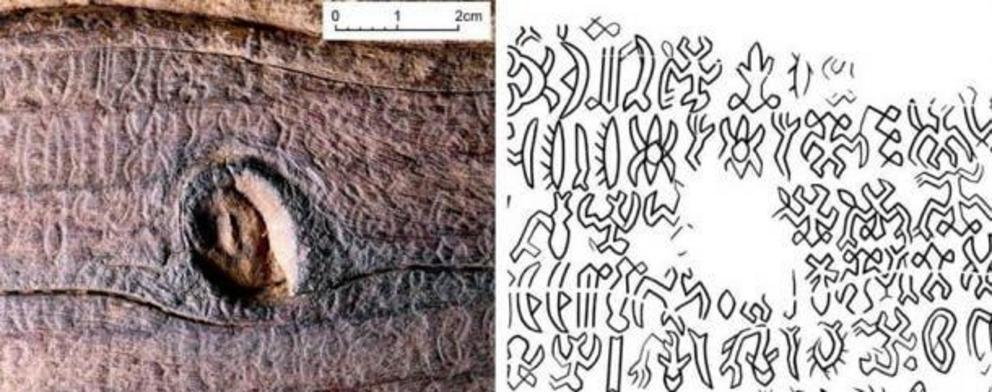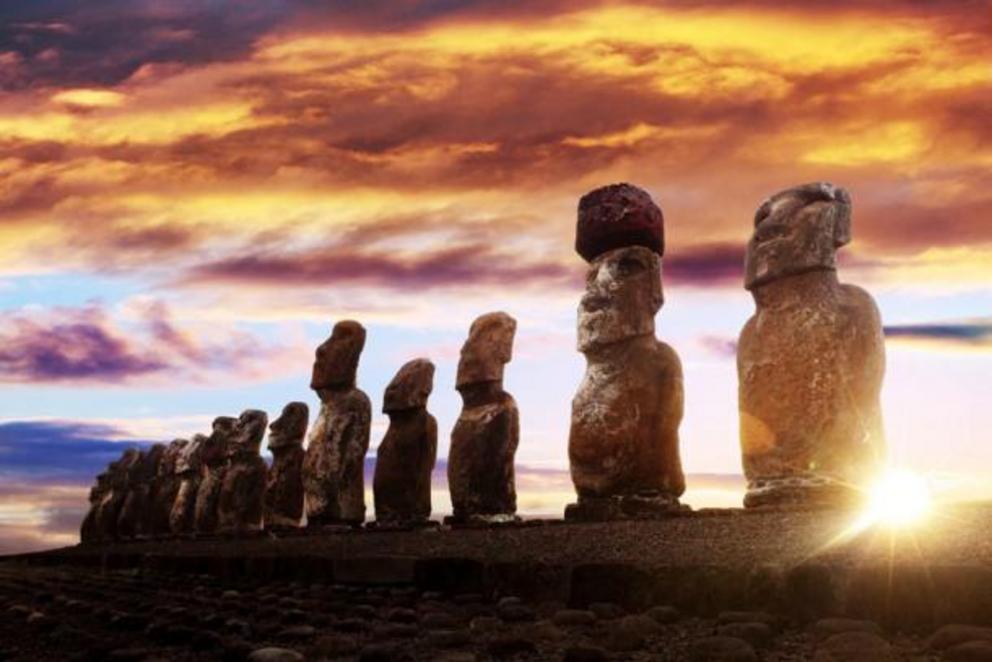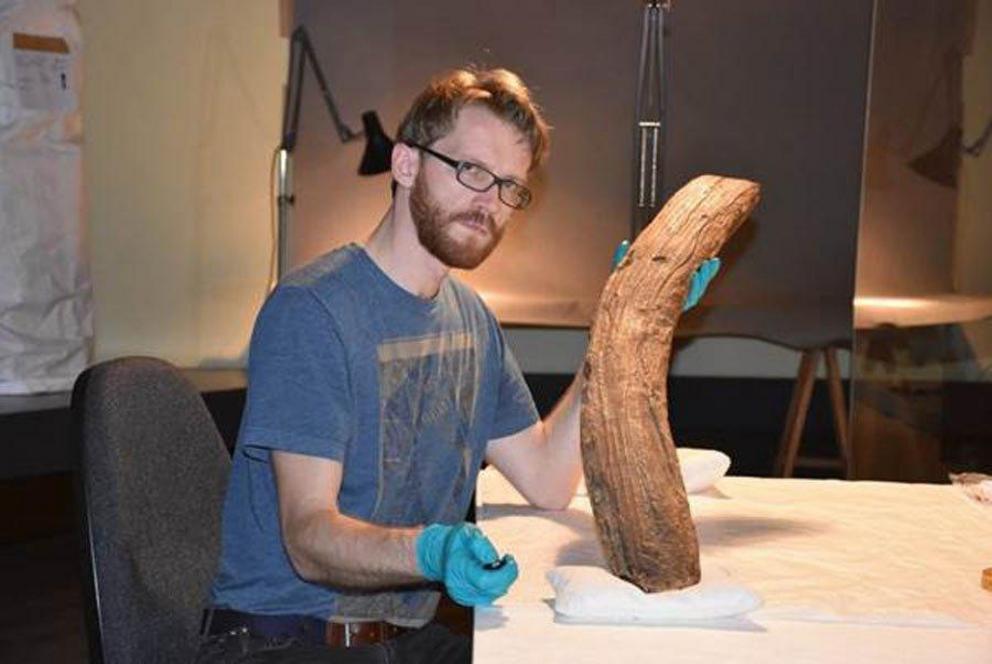3D analysis uncovers hidden details in Easter Island rongorongo tablet
Top image: Dr. Rafał Wieczorek at the Berlin Museum analyzing the rongorongo tablet.
Easter Island is best known for its gigantic stone monumental statues . But it has produced a number of other intriguing artifacts, including wooden rongorongo tablets and other items inscribed with a type of pictorial writing that is wholly unique to the island. Developed by the indigenous Rapa Nui people, this script—known as rongorongo—is comprised of glyphs (small stylized pictures of real-life objects or figures) that are strung together in rows to form sentences.
Museums around the world currently house 23 wooden artifacts recovered from Easter Island in the 19th century that feature rongorongo inscriptions. Until now little has been known about when they were carved, what type of wood was used to make them, and most importantly about what they actually say.
For the largest surviving rongorongo tablet, the first two of these questions have now been answered, thanks to the results of an innovative research project launched by a team of scientists led by chemist Rafał Wieczorek from the University of Warsaw in Poland, reports HeritageDaily. In conjunction with scientific testing, the researchers also created a three-dimensional model of the tablet, revealing hidden data that could ultimately help archaeologists, anthropologists, historians, and linguists decode the rongorongo communication system and discover the true meanings of its hundreds of symbols.
 The Berlin rongorongo tablet under analysis.
The Berlin rongorongo tablet under analysis.
Rongorongo Tablets: Exploring their Origins and Meaning
The scientists involved in this latest study, which was just published in the Journal of Island and Coastal Archaeology , gained access to a rongorongo tablet presently on display at the Ethnological Museum Dahlen in Berlin, Germany. The so-called Berlin Tablet was purchased by German visitors to Easter Island in 1882, and was later shipped back to Germany so it could be studied and preserved.
Of all 23 still-existing rongorongo-engraved artifacts, the Berlin Tablet is the largest in size. It is 41 inches (103 cm) long, five inches (12.5 cm) wide, and 2.4 inches (six cm) thick, and features inscriptions on both sides of the tablet. Unfortunately, one face has rotted away and is no longer legible to the naked eye, and similar damage has obscured more than half the script on the opposite side as well.
It is estimated that the Berlin Tablet contained over 5,000 separate glyphs in its original form. Out of this abundant display, only a small portion (perhaps 10 percent) can still be detected through normal observation. To find out more about the true origins of this enigmatic artifact, the scientists performed radiocarbon dating tests to determine its age and a botanical analysis to identify the wood used to make the rongorongo tablet.
Disproving previous predictions that suggested the artifact might have been hundreds of years old, their radiocarbon tests revealed that the artifact had likely been created in the first half of the 19th century. The scientists also disproved another theory about the tablets, namely that they had been produced using pieces of driftwood collected from Easter Island beaches. In fact, the rongorongo tablet was made from the wood of a Portia tree ( Thespesia populnea ), a species that had long grown naturally on Easter Island. The wood had been harvested from a tree that had been cut down sometime after the year 1810, meaning it was very much a modern artifact at the time of its recovery from an Easter Island cave.
 Details of the symbols on the rongorongo tablet.
Details of the symbols on the rongorongo tablet.
Creating a 3D Model of the Rongorongo Berlin Tablet
Perhaps the most interesting aspect of this project was the creation of the 3D model. The scientists took thousands of digital pictures of the artifact at the Berlin Museum from every angle imaginable, and combined all of these perspectives to create the most complete and thorough recreation of the tablet possible. The idea behind this project was to reveal hidden details on the tablet faces that the human eye couldn’t easily detect. And that is exactly what they achieved.
Because the tablet was so poorly preserved, the glyphs on its most decayed side are impossible to spot during a normal visual examination. But in their study of the three-dimensional model, the researchers were able to identify markings on both tablet sides.
“On the other side of the tablet and on its edges, we managed to see invisible symbols that have so far eluded researchers, as well as grooves similar to ones present on other rongorongo tablets,” Dr. Wieczorek explained in the Polish Press Agency Nauka W Polsce . “They served as lines delimiting the text and were to facilitate writing.”
Should similar procedures be performed on other inscribed wooden artifacts recovered from Easter Island, researchers may be able to expand their database of known rongorongo symbols. With this data, it would be much easier to decode and interpret the Rapa Nui text, and perhaps discover if it contains any similarities to other writing systems, in the Pacific region or elsewhere.
 Understanding the history of Easter Island, the Rapa Nui and the rongorongo tablets has long preoccupied historians.
Understanding the history of Easter Island, the Rapa Nui and the rongorongo tablets has long preoccupied historians.
The Story of How a Language Was Lost to Time
The Polynesian descendants of the Rapa Nui arrived on Easter Island sometime between the 12th and 13th centuries. They remained isolated from the outside world, until Spanish ships discovered the island in 1722. In 1770 the Spanish officially annexed Easter island, forcing the Rapa Nui people to accept their absorption into the Spanish Empire in the New World.
During the annexation ceremony, the Rapa Nui were shown written documents they were required to sign, signaling their supposed willingness to give up their independence to the Spanish. Some scholars believe this experience may have motivated the Rapa Nui people to develop their own written language, which followed a pictographic style that was different than the Spanish system. This may or may not be true (the system could have been developed much earlier, as Rapa Nui legends suggest). But from a timeline perspective, the results of the latest tests are consistent with this idea.
Rongorongo glyphs feature pictures of animals, natural objects, human beings, geometric symbols, and items that may represent indigenous cultural artifacts of various types. The glyphs are arranged in sequence on the wooden tablets, in a way that makes it clear they have meanings that are more complex than their pictures might suggest.
Rongorongo tablets were unknown to the outside world until they were discovered in 1864 by Brother Eugène Eyraud, a Christian missionary who lived among the Rapa Nui people. Just a few years earlier, there were people alive who understood this written language and could interpret the old tablets or even carve new ones.
The combined effects of Peruvian slaving raids in 1862 and the arrival of smallpox a few years later decimated the indigenous Rapa Nui population, largely wiping out the literate Rapa Nui aristocratic and priestly classes and leaving no one behind who could read the rongorongo script. Knowledge of the rongorongo written language was lost as a result of these tragedies, which reduced the population of the island from approximately 3,000 in the mid-19th century to little more than 100 people by the 1880s.
Righting a Historical Wrong
Most ancient languages have been lost to the passage of time. But the unique and fascinating language of the indigenous residents of Easter Island was a casualty of negligence and exploitation, of the type experienced by most indigenous people who came into contact with European colonizers and their descendants.
If researchers are eventually able to decode and properly interpret the rongorongo script , it could reveal many enlightening details about the lives and lifestyles of the Rapa Nui people who have occupied Easter Island for nearly 1,000 years. This will be valuable to scholars, but it may be even more valuable to the modern Rapa Nui residents of the island, who deserve to know more about who their ancestors really were and about what they accomplished.

